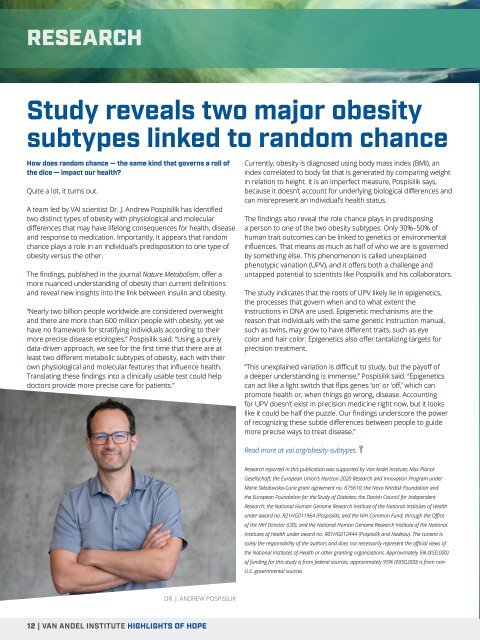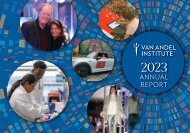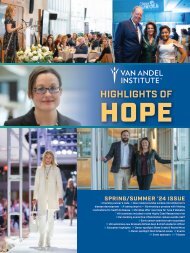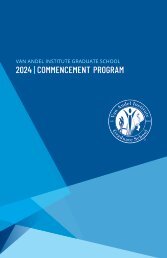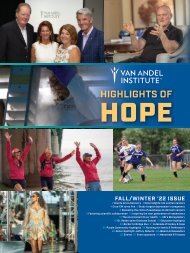Highlights of Hope Spring/Summer 23
This is the 2023 Spring/Summer edition of Van Andel Institute's Highlights of Hope donor publication.
This is the 2023 Spring/Summer edition of Van Andel Institute's Highlights of Hope donor publication.
Create successful ePaper yourself
Turn your PDF publications into a flip-book with our unique Google optimized e-Paper software.
RESEARCH<br />
Study reveals two major obesity<br />
subtypes linked to random chance<br />
How does random chance — the same kind that governs a roll <strong>of</strong><br />
the dice — impact our health?<br />
Quite a lot, it turns out.<br />
A team led by VAI scientist Dr. J. Andrew Pospisilik has identified<br />
two distinct types <strong>of</strong> obesity with physiological and molecular<br />
differences that may have lifelong consequences for health, disease<br />
and response to medication. Importantly, it appears that random<br />
chance plays a role in an individual’s predisposition to one type <strong>of</strong><br />
obesity versus the other.<br />
The findings, published in the journal Nature Metabolism, <strong>of</strong>fer a<br />
more nuanced understanding <strong>of</strong> obesity than current definitions<br />
and reveal new insights into the link between insulin and obesity.<br />
“Nearly two billion people worldwide are considered overweight<br />
and there are more than 600 million people with obesity, yet we<br />
have no framework for stratifying individuals according to their<br />
more precise disease etiologies,” Pospisilik said. “Using a purely<br />
data-driven approach, we see for the first time that there are at<br />
least two different metabolic subtypes <strong>of</strong> obesity, each with their<br />
own physiological and molecular features that influence health.<br />
Translating these findings into a clinically usable test could help<br />
doctors provide more precise care for patients.”<br />
Currently, obesity is diagnosed using body mass index (BMI), an<br />
index correlated to body fat that is generated by comparing weight<br />
in relation to height. It is an imperfect measure, Pospisilik says,<br />
because it doesn’t account for underlying biological differences and<br />
can misrepresent an individual’s health status.<br />
The findings also reveal the role chance plays in predisposing<br />
a person to one <strong>of</strong> the two obesity subtypes. Only 30%–50% <strong>of</strong><br />
human trait outcomes can be linked to genetics or environmental<br />
influences. That means as much as half <strong>of</strong> who we are is governed<br />
by something else. This phenomenon is called unexplained<br />
phenotypic variation (UPV), and it <strong>of</strong>fers both a challenge and<br />
untapped potential to scientists like Pospisilik and his collaborators.<br />
The study indicates that the roots <strong>of</strong> UPV likely lie in epigenetics,<br />
the processes that govern when and to what extent the<br />
instructions in DNA are used. Epigenetic mechanisms are the<br />
reason that individuals with the same genetic instruction manual,<br />
such as twins, may grow to have different traits, such as eye<br />
color and hair color. Epigenetics also <strong>of</strong>fer tantalizing targets for<br />
precision treatment.<br />
“This unexplained variation is difficult to study, but the pay<strong>of</strong>f <strong>of</strong><br />
a deeper understanding is immense,” Pospisilik said. “Epigenetics<br />
can act like a light switch that flips genes ‘on’ or ‘<strong>of</strong>f,’ which can<br />
promote health or, when things go wrong, disease. Accounting<br />
for UPV doesn’t exist in precision medicine right now, but it looks<br />
like it could be half the puzzle. Our findings underscore the power<br />
<strong>of</strong> recognizing these subtle differences between people to guide<br />
more precise ways to treat disease.”<br />
Read more at vai.org/obesity-subtypes.<br />
Research reported in this publication was supported by Van Andel Institute; Max Planck<br />
Gesellschaft; the European Union’s Horizon 2020 Research and Innovation Program under<br />
Marie Skłodowska-Curie grant agreement no. 675610; the Novo Nordisk Foundation and<br />
the European Foundation for the Study <strong>of</strong> Diabetes; the Danish Council for Independent<br />
Research; the National Human Genome Research Institute <strong>of</strong> the National Institutes <strong>of</strong> Health<br />
under award no. R21HG011964 (Pospisilik); and the NIH Common Fund, through the Office<br />
<strong>of</strong> the NIH Director (OD), and the National Human Genome Research Institute <strong>of</strong> the National<br />
Institutes <strong>of</strong> Health under award no. R01HG012444 (Pospisilik and Nadeau). The content is<br />
solely the responsibility <strong>of</strong> the authors and does not necessarily represent the <strong>of</strong>ficial views <strong>of</strong><br />
the National Institutes <strong>of</strong> Health or other granting organizations. Approximately 5% ($50,000)<br />
<strong>of</strong> funding for this study is from federal sources; approximately 95% ($950,000) is from non-<br />
U.S. governmental sources.<br />
DR. J. ANDREW POSPISILIK<br />
12 | VAN ANDEL INSTITUTE HIGHLIGHTS OF HOPE


